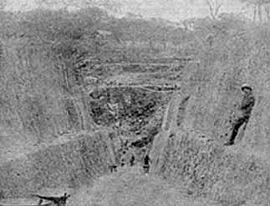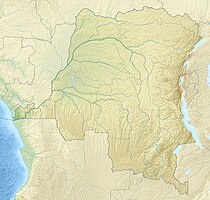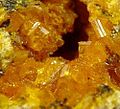Shinkolobwe Mine
| Shinkolobwe Mine | |||
|---|---|---|---|
| General information about the mine | |||
| Shinkolobwe uranium mine, 1925 | |||
| other names | Kasolo mine | ||
| Mining technology | Underground mining | ||
| Information about the mining company | |||
| Start of operation | 1915 | ||
| End of operation | 1960 | ||
| Funded raw materials | |||
| Degradation of | Copper-cobalt-nickel-uranium deposit | ||
| Geographical location | |||
| Coordinates | 11 ° 2 ′ 30 ″ S , 26 ° 33 ′ 0 ″ E | ||
|
|||
| Location | Shinkolobwe | ||
| province | Skin katanga | ||
| Country | Democratic Republic of Congo | ||
The shinkolobwe (also Chinkolobwe ) is a uranium - and cobalt - mine and also a former settlement in the province of Haut-Katanga of the Democratic Republic of Congo . Shinkolobwe is located around 20 km west of the city of Likasi, which has a population of around 400,000 .
The uranium (or plutonium extracted from it ) used to build the atomic bombs dropped on Hiroshima and Nagasaki came from this mine.
History and geology

The Shinkolobwe mine, which was operated from 1915 to 1960, is located on the Kasolo Hill (therefore also sometimes referred to as the Kasolo Mine ) and is considered to be the richest ore deposit in the world. In Shinkolobwe, copper was extracted on a small scale several centuries ago. In 1915, projector Major Sharp discovered uranium minerals during survey work. The epigenetic floor deposit was in 1921 in the open pit and in underground mining dismantled. The largest purchaser of the uranium mined by the Belgian Union Minière du Haut Katanga (UMHK) was the USA . In 1940 over 1,000 tons of high-percentage uranium ore from Shinkolobwe were shipped to the United States. This was later used as part of the Manhattan Project to build the atomic bombs that were dropped on Hiroshima and Nagasaki in 1945 . The mining company initially continued to mine uranium even after the Second World War.
When Belgium withdrew from the Congo in 1960, ore mining in Shinkolobwe was ended and the tunnels filled with concrete. However, these measures did not prevent further ore, mainly copper and cobalt (e.g. the cobalt oxide heterogenite ), from being mined illegally and by hand - mostly by women and children - especially since the 1990s . The uranium-containing, radioactive overburden was deposited in an uncontrolled manner in the area, partly used to backfill uneven terrain or to build roads. In 2004 several people were killed when a pit collapsed and Shinkolobwe was (again) closed by presidential decree. The mining settlement, where around 15,000 people lived, was burned down. Nevertheless, illegal ore mining (micro-mining) took place and continues to be. In 2006 it was reported that Iran attempted to import uranium from Katanga - presumably Shinkolobwe. So far, no effective measures have been taken to eliminate environmental damage and the contamination of residential areas and drinking water by toxic or radioactive minerals, and there is still a risk of radioactive material being smuggled abroad.
Mineral finds
A total of 124 minerals and 9 varieties have been detected in Shinkolobwe so far (as of 2015) . Shinkolobwe is also the type locality for 34 minerals . Shinkolobwe holds 6th place among the sites with the most type locality minerals. Uranium in Shinkolobwe is mainly accompanied by cobalt and nickel . There is almost no copper . The main nickel sulfide is vaesite .
Type localities
Some of the minerals first discovered in Shinkolobwe include the following:
- Becquerelite Ca [(UO 2 ) 6 | O 4 | (OH) 6 ] • 8H 2 O
- Bijvoetite- (Y) Y 8 (UO 2 ) 16 O 8 (CO 3 ) 16 (OH) 8 • 39H 2 O
- Billietite Ba [(UO 2 ) 6 | O 4 | (OH) 6 ] • 8H 2 O
- Cattierite CoS 2
- Comblainit Ni 4 Co 3+ 2 (CO 3 ) (OH) 12 · 3H 2 O
- 'Cousinite' (possibly "Mg-Umohoite") MgU 2 Mo 2 O 13 · 6H 2 O
- Curit Pb 3 [(UO 2 ) 4 | O 4 | (OH) 3 ] 2 · 2 H 2 O
- Dewindtite Pb 3 [H (UO 2 ) 3 O 2 (PO 4 ) 2 ] 2 • 12H 2 O
- Dumontite Pb 2 (UO 2 ) 3 O 2 (PO 4 ) 2 • 5H 2 O
- Fourmarierite Pb (UO 2 ) 4 O 3 (OH) 4 • 4H 2 O
- Ianthinite U 4+ 2 [(UO 2 ) 4 | O 6 | (OH) 4 ] • 9H 2 O
- Kasolit (Pb (UO2) SiO4 · H 2 O) was named after its type locality ( Kasolo Mine )
- Lepersonnite- (Gd) Ca (Gd, Dy) 2 (UO 2 ) 24 (SiO 4 ) 4 (CO 3 ) 8 (OH) 24 · 48H 2 O
- Masuyite Pb [(UO 2 ) 3 | O 3 | (OH) 2 ] • 3H 2 O
- Metasaleity Mg (UO 2 ) 2 (PO 4 ) 2 · 8H 2 O
- Metaschoepit UO 3 · nH 2 O (n≈2)
- Metastudtite (UO 2 ) (O 2 ) (H 2 O) 2
- Metavandendriesscheit Pb 1.57 [(UO 2 ) 10 | O 6 | (OH) 11 ] · nH 2 O (n <11)
- Oursinite (Co, Mg) (UO 2 ) 2 Si 2 O 7 · 6H 2 O
- Paraschoepit UO 3 · nH 2 O (n <2)
- Parsonsite Pb 2 UO 2 (PO 4 ) 2 · 2H 2 O
- Piretite Ca (UO 2 ) 3 (SeO 3 ) 2 (OH) 4 · 4H 2 O
- Protasite Ba (UO 2 ) 3 O 3 (OH) 2 · 3H 2 O
- Richite (Fe 3+ , Mg) xPb 2+ 8.6 (UO 2 ) 36 O 36 (OH) 24 · 41H 2 O
- Roubaultite Cu 2 (UO 2 ) 3 (CO 3 ) 2 O 2 (OH) 2 · 4H 2 O
- Saléeit (Co-type locality) Mg (UO 2 ) 2 (PO 4 ) 2 · 10H 2 O
- Sayrit Pb 2 (UO 2 ) 5 O 6 (OH) 2 · 4H 2 O
- Schoepit [(UO 2 ) 4 | O | (OH) 6 ] • 6H 2 O
- Sharpit Ca (UO 2 ) 6 (CO 3 ) 5 (OH) 4 • 6H 2 O
- Sklodovskite (H 3 O) 2 Mg (UO 2 ) 2 (SiO 4 ) 2 · 2H 2 O
- Soddyite (UO 2 ) 2 (SiO 4 ) · 2 H 2 O
- Stilleit ZnSe
- Studtite [(UO 2 ) (O 2 ) (H 2 O) 2 ] (H 2 O) 2
- Uranium calcarite Ca (UO 2 ) 3 (CO 3 ) (OH) 6 · 3H 2 O
- Vandendriess Pb 1.57 [(UO 2 ) 10 | O 6 | (OH) 11 ] · 11H 2 O
- Wyartite CaU 5+ (UO 2 ) 2 (CO 3 ) O 4 (OH) • 7H 2 O, Wyartite-II CaU 5+ (UO 2 ) 2 O 4 CO 3 (OH) • 3H 2 O
- Minerals from Shinkolobwe
literature
- Bonnie Campbell (Ed.): Mining in Africa: Regulation and Development . Pluto Press, 2009, ISBN 978-0745329390 , p. 208.
- JP Richards: Mining, society and a sustainable world . Springer, 2009, ISBN 978-3642011023 , pp. 308-309.
- Sean Rorison: Congo: Democratic Republic and Republic. Bradt Pub., 2008, ISBN 978-1841622330 , p. 145.
- Michael Schaaf: Nuclear fission in the heart of darkness. Africa and the origins of the nuclear age. in: Vera Keizer (ed.): Radiochemistry, diligence and intuition. New research on Otto Hahn. Berlin 2018. ISBN 978-3-86225-113-1
- Josef Lhoest, Eddy van der Meersche: Lapis . Volume 17, No. 3 edition. Christian Weise Verlag GmbH, 1992, ISSN 0176-1285 , p. 24 (special issue: Shaba).
Individual evidence
- ↑ Michael Schaaf: Nuclear fission in the heart of darkness. Africa and the origins of the nuclear age. in: Vera Keizer (ed.): Radiochemistry, diligence and intuition. New research on Otto Hahn. Berlin 2018. ISBN 978-3-86225-113-1 , pp. 433ff
- ↑ a b Description of the location and mineral list of the Shinkolobwe Mine near Mindat Mindat (English)
- ↑ Iran's plot to mine uranium in Africa . Sunday Times, 6 August 2006 (English)
- ↑ Top 50 list of type localities at Mindat Mindat (English)
Web links
- Description of the location in the Mineralienatlas
- VDC Daltry: The type mineralogy of Africa: Zaire In: Annales de la Société Géologique de la Belgique , T. 115 (fasc. 1), 1992, pp. 33-62 online
- Madeleine Drohan: Toxic Lode - The Mines of Shinkolobwe In: Amnesty International Magazine , Winter 2008 online
- Tom Zoellner: A (Radioactive) Cut in the Earth That Will Not Stay Closed In: Scientific American , March 27, 2009 online





